A Simple Guide to Google Ads Optimization
As the world’s largest and most widely used online advertising platform, Google Ads has helped millions of advertisers to reach new customers and grow their businesses.
However, for all the ease and accessibility promised by Google advertising, many newcomers to paid search find themselves disappointed by the results of their first campaigns. Why? Because they haven’t properly optimized their Google Ads account.
Google Ads optimization can be intimidating at first, but it doesn’t have to be. In fact, optimizing a Google account can be much easier than you might think. All it takes is a little planning and preparation, as well as adhering to some well-established PPC best practices.
Google Ads Account Structure Optimization
Of all the various elements you can optimize within Google Ads, the actual structure of your account is arguably the most important.
Poorly structured accounts can lead to a range of problems, from lower Quality Scores – and the higher costs often incurred as a result – to fewer or irrelevant clicks and many more issues. The key to an optimally structured Google account is organization, and by spending a little time properly structuring the elements that make up your Google paid search account, you’ll be in great shape to start reaching prospective customers with your ads.
Here’s what an optimally structured account looks like:
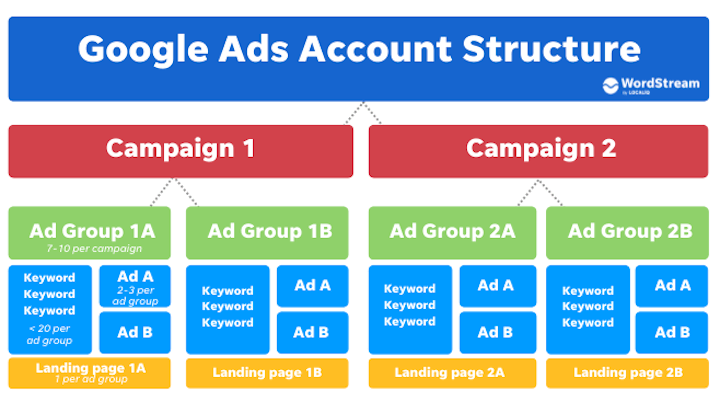
As you can see, this example account is comprised of four main elements:
- Campaigns
- Ad groups
- Ads
- Keywords
A single Google Ads account can have multiple campaigns active at any one time. In this example, this account has two campaigns, Campaign 1 and Campaign 2. The first campaign might be a search campaign (which typically means text-based ads served to Google users who are searching for things using Google), whereas Campaign 2 could be a Display campaign, which favors more visual ads such as banners across a vast network of sites that spans almost the entirety of the web.
Moving further down our Google Ads account structure diagram, you’ll notice that each campaign has two ad groups; Campaign 1 is comprised of Ad Group 1a and Ad Group 1b, while Campaign 2 is comprised of Ad Group 2a and Ad Group 2b.
As their name implies, ad groups are groups of ads that have been organized and categorized by semantic relevance. This means that your ad groups’ keywords should be organized by their meaning. For example, if you run a clothing and apparel store, Ad Group 1a might be comprised of keywords relating to hats and scarves, while Ad Group 1b might focus exclusively on jackets and coats. Finally, you can see that each Ad Group has its own keywords, as well as two individual ads that feature the semantically related keywords of that ad group.
Structuring a Google Ads account in this way offers a range of benefits. Not only does this approach make managing your account easier, it also ensures your ads and their related ad groups are as relevant as possible. This, in turn, means that your ads will be shown to the right people, at the right time, in the right place. There are other considerations to be taken into account besides account structure when it comes to the visibility of your ads, such as bidding strategies, keyword match type, and other targeting parameters, but structuring your account logically and semantically should be the first step in any Google ads optimization workflow.
For more details on how to optimally structure your account, check out the last guide to Google Ads account structure you’ll ever need.
Optimizing Your Ad Settings to Lower Costs
There are a number of ways to control your Google Ads costs by optimizing various settings and targeting options in your account.
Negative Keywords
Despite their name, negative keywords are not keywords with negative connotations, but rather keywords that an advertiser may not want their ads to appear alongside in user searches.
For example, say you run a gardening supply store. You’re planning your first campaign, and it’s time to select which keywords you want to bid on. Surely any keyword that includes the phrase “garden” is relevant, right?
Not exactly. What about an informational search for trivia about the 2004 romantic comedy movie, Garden State? Or searches for music by ‘90s pop band Savage Garden? Or a navigational search for the customer service department of Better Homes and Gardens magazine? None of these searches would ever convert for our hypothetical garden supply store, and as such keywords like this should be excluded from your campaigns as negative keywords.
Since advertisers are charged a certain amount of money every time somebody clicks on an ad (hence the name “pay-per-click advertising”), it’s vital that advertisers exclude irrelevant search terms from their campaigns, or they’ll end up paying money for clicks that will never convert. Despite the importance of excluding negative keywords, it’s amazing how many advertisers – especially newcomers to paid search – fail to exclude wasteful keywords.
For more information about excluding negatives and building negative keyword lists, check out this guide to building a negative keyword list.
Targeting Parameters
One of Google Ads’ greatest strengths is the granularity with which advertisers can target prospective customers. However, as powerful as Google’s targeting options are, they require care and attention if your ads are to be seen by the right people, at the right time, in the right place.
Although Google Ads’ primary targeting option is keywords, there are many other parameters that advertisers can use in their campaigns.
How to Optimize Your Geolocation Settings
The first Google Ads targeting parameter we will be optimizing is our geolocation settings. Google Ads allows advertisers to refine the areas in which their ads are shown. This does not mean ads’ location or position on search engine results pages, but rather where prospective customers are in the real world at the time they conduct their searches.
For example, let’s say you run a locksmith business in Boston. Your business’s primary operating area is the greater metropolitan Boston area, which encompasses many other towns and cities beyond Boston’s city limits. Given the local focus of your locksmith business, we need to set our geolocation targeting parameters to ensure that only prospective customers located in or near Boston are shown our ads alongside relevant search results.
We can do this by examining our geolocation settings in Google Ads. These can be found in our Campaign settings, which can be accessed via the Settings > Location & Languages > Locations tab.
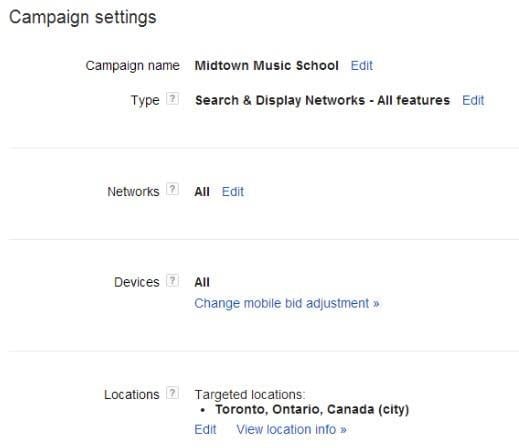
From here, we can specify the locations in which we want our ads to be served. To begin, simply start typing the name of the desired location in the relevant field, then select the location from the list. Note that you can target entire states or provinces, individual cities, specific zip and postal codes, and even certain individual airports.
You can also target specific locations via radius targeting. This allows you to specify that your ads be shown to users within a specified radius of a certain point i.e. within a 20-mile radius of a specific city. Using our hypothetical locksmith business as an example, we can set our geolocation radius to encompass a 20-mile radius around the city of Boston, as shown below:
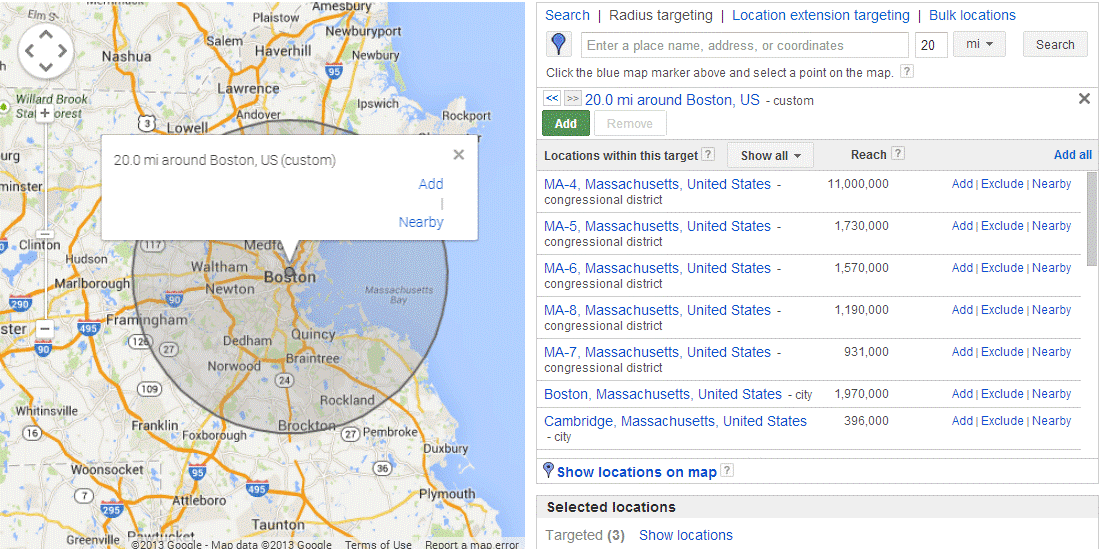
Businesses operating in specific regional markets or individual cities must ensure their geolocation parameters are set correctly in order to maximize the impact of their campaigns. For more information on optimizing Google Ads’ location settings, check out this comprehensive guide to location targeting in Google Ads.
How to Optimize Your Dayparting Settings
In addition to setting the desired location parameters within Google Ads, we can also optimize the days and times during which our ads should be shown to prospective customers. This is achieved by adjusting our dayparting settings, which can be accessed at the Campaign level via the Dimensions tab.
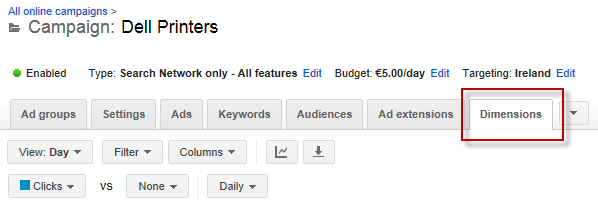
By navigating to View > Time > Day of the Week (you can also set specific time parameters here by selecting Hour of the day), we can see which days of the week are most active in terms of Clicks, Impressions, Click-through rate, Average cost-per-click, and Cost.
As you can see in the figure below, this campaign saw heightened activity on Tuesday and Wednesday (which we can see in the Clicks and Impressions), but click-through rates were almost twice as high on Sundays. If we wanted to capitalize on this trend, we could use Google Ads’ dayparting settings to prioritize serving ads on Sundays.
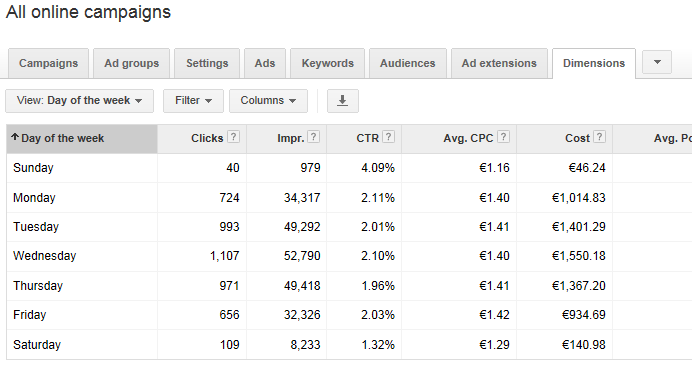
To do this, we need to access our ad scheduling options. These can be accessed by navigating to the Settings tab in our Campaign view, then selecting “Ad schedule”:
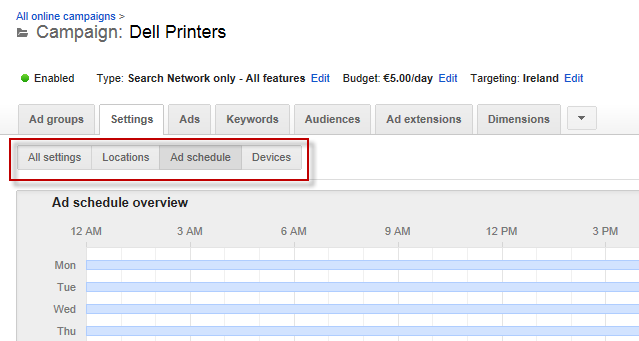
Now simply click the red “Ad Schedule” button, then choose the days of the week and times of day you wish your ads to be displayed.
Combining dayparting settings with geolocation targeting parameters can be an immensely powerful way to refine where and when your ads are shown to prospective customers. For more information on optimizing dayparting settings in Google Ads, check out this guide to geolocation targeting and local PPC.
Google Ads Bid Optimization
Google’s bidding options are highly granular and nuanced, allowing you to exercise a great deal of control over how and when you bid on the most valuable keywords for your business. However, since your bidding strategy has a direct impact on how your ad budget is allocated and spent, it’s vital to adjust your bidding settings carefully.
Bidding in Google Ads can be handled manually, but it can also be automated by using Google Ads scripts (small snippets of code typically written in JavaScript that perform specific tasks automatically) and conditional triggers i.e. bidding more on keywords targeting mobile traffic or certain kinds of mobile devices, bidding less on keywords during specific times, and dozens of other parameters.
As important as bid management is to any Google Ads optimization workflow, it’s important to note that utilizing the right bidding strategy isn’t just a way to ensure your ad budget is being spent wisely – it’s also important from a performance standpoint.
For example, to continue our Boston-based locksmith business example from earlier, let’s say we want our ads to be shown to people searching for locksmiths after finding themselves locked out of their homes. Given that this type of query has very strong commercial intent, we want to prioritize targeting these prospective customers over others because these searches are much more likely to result in a conversion.
We can do this by adjusting our bidding strategy to bid more on keywords such as “locksmiths near me” or “locksmiths near my location”; these keywords are potentially much more valuable than queries with less commercial intent, so it makes sense that we would bid more on these keywords. We could also set higher bids for searches containing these keywords performed on a mobile device, as this also signifies strong commercial intent.
Bidding in Google Ads is a veryGoogle Adsbroad and complex topic that is largely beyond the scope of this guide. To learn more about bidding strategies in Google Ads, check out the following resources:
- Google Ads Bid Management Guide
- Easy Bidding Strategies for Newbies & Math Haters
- 5 Google Ads Scripts for Smarter Bidding
Optimizing Ad Text and Landing Pages in Google Ads
The final element of our Google Ads optimization guide is among the most important – optimizing ad text and our ads’ accompanying landing pages.
Optimizing ad text can be challenging for many advertisers, particularly those with large campaigns featuring dozens of ad groups. To complicate matters, ads should be optimized for both desktop and mobile campaigns, including which extensions should be used. Add this to the everyday pressures of running a business and it becomes clear why so many advertisers struggle to keep their text ads tightly optimized.
There are as many ways to write an effective text ad as there are businesses advertising on Google Ads. However, the best Google Ads ads all share several qualities.
The best text ads:
- Include a relevant keyword at least once, especially in the headline
- Effectively convey your business’ unique selling proposition (USP), or the reason why prospective customers should choose your business over a competitor
- Feature a compelling call-to-action (CTA) that tells the prospect what to do and what to expect when they click on your ad
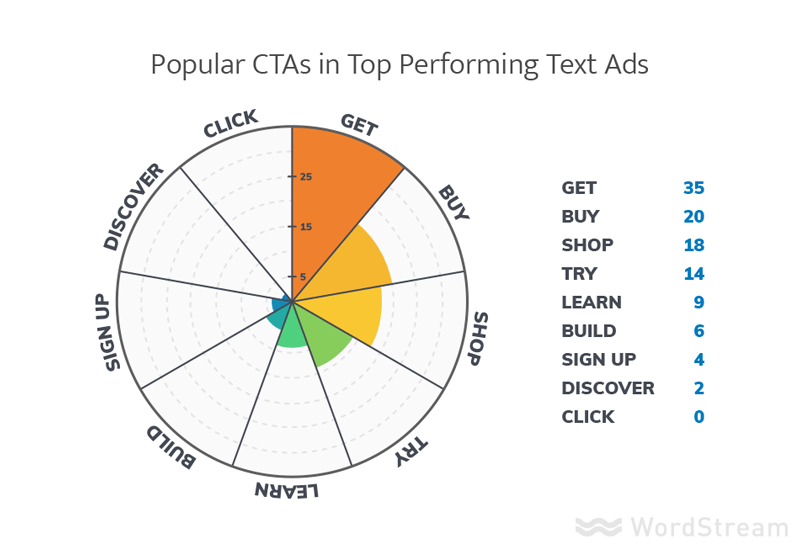
Feature-Driven Ads vs. Benefit-Driven Ads
Making sure your ads include the elements above is an excellent first step toward creating better-performing, higher-converting text ads. However, that alone isn’t enough – you also have to consider how you frame your ads.
There are two primary ways of framing or positioning your ads: feature-driven, or benefit-driven. Although feature-driven messaging can be effective in certain circumstances, benefit-driven ads tend to perform more strongly. This is because benefit-driven ads appeal to consumers’ main desire – to solve a specific problem. As such, benefit-driven ads often use connecting language such as “us” and “we” to create and reinforce a relationship with the prospect, and use aspirational, evocative language to help would-be customers visualize how much better their lives would be if they used your products or services.
Using Active Language in Text Ads
Regardless of whether your ads are primarily feature- or benefit-driven, the actual language you choose to employ can have a dramatic impact on the performance of your ads and campaigns. Using strong, active verbs can make your ads significantly more compelling.
In the figure below, you’ll see two ads. The original ad (which would be called the “control” ad in an A/B or multivariate test) is on the left, while the new, revised ad (known as the “variant”) is on the right.

There are slight differences in the copy of each ad, but note the inclusion of a strong, active verb (“Increase”) in the variant. This ad increased clicks by 150%, meaning that the use of an active verb in the headline more than doubled that ad’s performance.
If your ads are struggling to achieve the results you want, it might be worth rewriting some of your older ads and testing them to see how they stack up.
Get a Free Report to Check Your Google Ads Account Optimization
If you’re looking for a quick and easy way to check your Google advertising account for optimization in all these areas, try the free Google Ads Performance Grader.
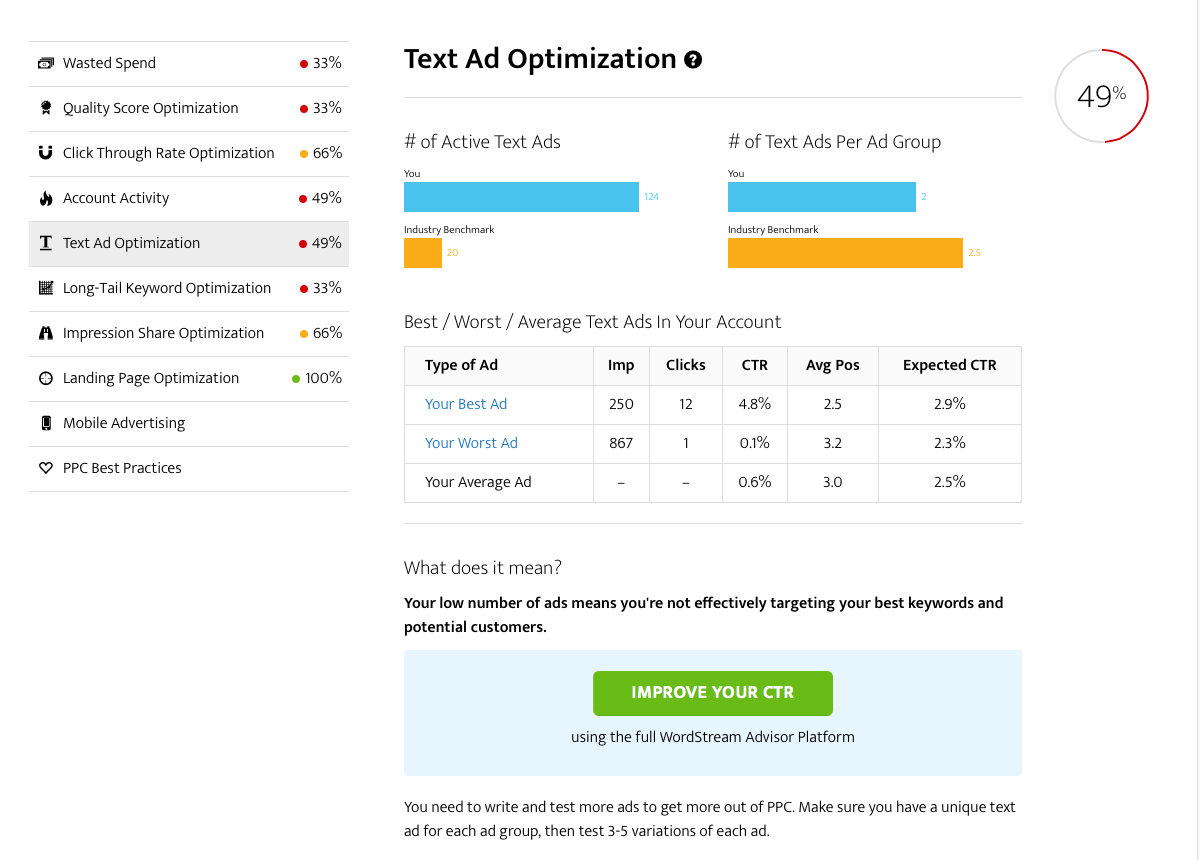
This award-winning tool runs a fast audit on your Google Ads account and delivers a complete report that shows you where your account is optimized and where it needs work. Try it now for free.
